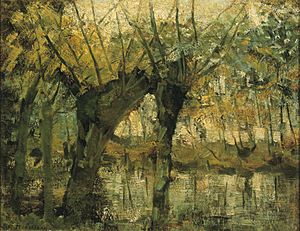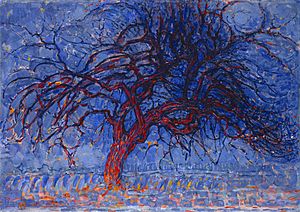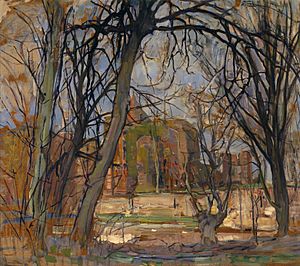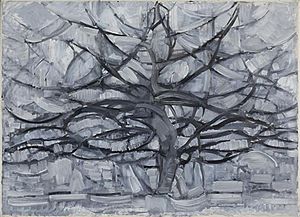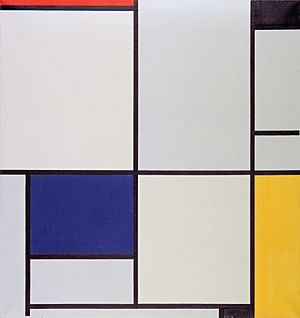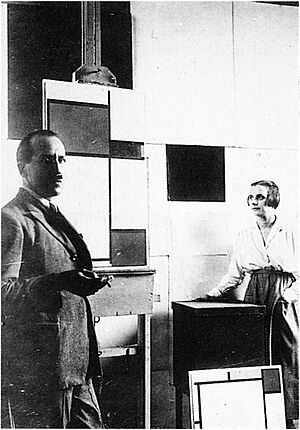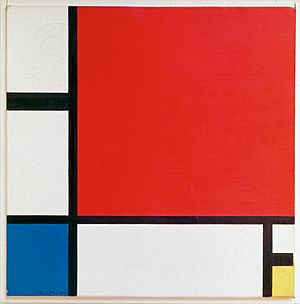Piet Mondrian facts for kids
Quick facts for kids
Piet Mondrian
|
|
|---|---|
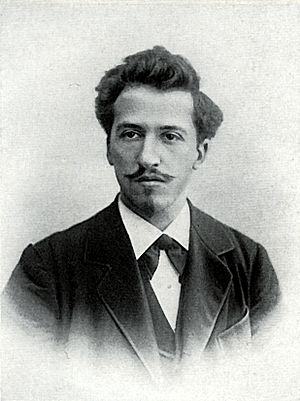
After 1906
|
|
| Born |
Pieter Cornelis Mondriaan
7 March 1872 Amersfoort, Netherlands
|
| Died | 1 February 1944 (aged 71) New York City, U.S.
|
| Education | Rijksakademie van beeldende kunsten |
| Known for | Painting |
|
Notable work
|
Evening; Red Tree, Gray Tree, Composition with Red Blue and Yellow, Broadway Boogie Woogie, Victory Boogie Woogie |
| Movement | De Stijl, abstract art |
Pieter Cornelis Mondriaan was a famous Dutch painter and art thinker. After 1906, he became known as Piet Mondrian. He was born on March 7, 1872, and passed away on February 1, 1944. Many people consider him one of the most important artists of the 20th century.
Mondrian was a leader in abstract art. He started with realistic paintings, but slowly changed his style. His art became more and more abstract. Eventually, he used only simple shapes and colors in his work. He believed art should be above everyday reality. He thought art could help people connect with deeper, spiritual ideas.
He helped start the De Stijl art movement with Theo van Doesburg. In this group, he created a new style called Neoplasticism. This style used only the three primary colors (red, blue, and yellow). It also used black, white, and gray. He limited his shapes to only horizontal and vertical lines. Mondrian moved to Paris in 1911. There, he saw Cubism and changed his name slightly to fit in with the new art scene.
Mondrian's work had a huge impact on 20th century art. It influenced abstract painting and other art movements. It also affected design, architecture, and fashion. Design historian Stephen Bayley said Mondrian's work became a symbol for Modernism.
Contents
The Life of Piet Mondrian
Early Years in the Netherlands (1872–1911)

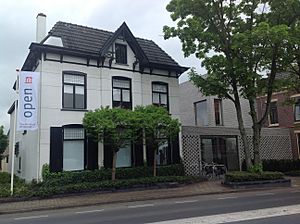
Piet Mondrian was born in Amersfoort, Netherlands. He was the second child in his family. His family moved to Winterswijk when his father became a head teacher. Mondrian learned about art from a young age. His father was a drawing teacher. His uncle, Fritz Mondrian, was also an artist. Young Piet often painted and drew with them.
In 1892, Mondrian joined the Academy for Fine Art in Amsterdam. He was already a qualified teacher. He started his career teaching in schools, but he also painted. Most of his early work was realistic, showing landscapes. These paintings showed windmills, fields, and rivers from his home country.
These early paintings show how different art styles influenced him. He used styles like pointillism and the bright colors of Fauvism. His first art exhibition was in 1893. The Gemeentemuseum Den Haag has many of his early works. One painting, Evening (1908), shows a tree at dusk. It uses mostly red, yellow, and blue, hinting at his future style.
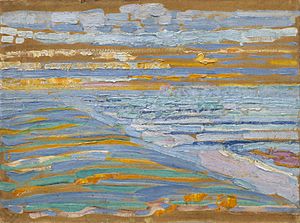
Mondrian's first abstract paintings were from 1905 to 1908. They showed blurry scenes of trees and houses reflected in water. These paintings started to focus on shapes more than the actual scene. But they were still based on nature.
Mondrian's art was also connected to his spiritual beliefs. In 1908, he became interested in Theosophy. This was a spiritual movement started by Helena Blavatsky. He joined the Dutch Theosophical Society in 1909. Blavatsky's ideas deeply affected his art. She believed in finding deeper knowledge of nature. Mondrian spent his life searching for this spiritual knowledge through his art.
In 1911, Mondrian saw an exhibition of Cubism in Amsterdam. This greatly influenced him. He began to simplify his art. You can see this in his Still Life with Ginger Pot paintings. The 1911 version is Cubist. The 1912 version reduces objects to simple shapes like circles, triangles, and rectangles.
Parisian Adventures (1911–1914)
In 1911, Mondrian moved to Paris. He changed his name by dropping an "a" from "Mondriaan". This showed he was leaving his Dutch past behind. He wanted to join the new art scene in Paris. The Cubism of Pablo Picasso and Georges Braque quickly influenced his work.
Paintings like The Sea (1912) and his tree studies still showed some real objects. But they were more and more made of geometric shapes. Mondrian used Cubism as a step in his art journey. He did not see it as his final style. His Cubist period lasted from 1912 to 1917.
Back in the Netherlands (1914–1918)
Mondrian wanted his painting to connect with his spiritual ideas. In 1913, he started to combine his art and spiritual studies. This led to his final break from realistic painting. While visiting the Netherlands in 1914, World War I began. He had to stay there during the war.
He lived in an artists' village called Laren. There, he met Bart van der Leck and Theo van Doesburg. They were also exploring abstract art. Van der Leck's use of only primary colors greatly influenced Mondrian. Mondrian wrote that Van der Leck's precise method changed his own Cubist style.
With Van Doesburg, Mondrian started De Stijl (The Style). This was an art journal. In it, he first wrote about his art theory, which he called Neoplasticism. He published "The New Plastic in Painting" in parts from 1917 to 1918. This was his first big effort to explain his art ideas. For the next 20 years, Mondrian developed his unique style. He focused on horizontal and vertical black lines. These lines formed squares and rectangles filled with primary colors.
Parisian Masterpieces (1918–1938)
After World War I ended in 1918, Mondrian went back to France. He stayed there until 1938. Paris was full of new art ideas after the war. Mondrian thrived there. He fully embraced pure abstract art for the rest of his life. He started making grid-based paintings in late 1919. By 1920, his famous style began to appear.
In his early paintings of this style, the lines were thin and gray. They often faded near the edge of the painting. The shapes were smaller and more numerous. Most were filled with primary colors, black, or gray. Only a few were left white.
By late 1920 and 1921, Mondrian's paintings reached their well-known form. Thick black lines now separated larger, fewer shapes. More shapes were left white. But his art still kept changing. The changes became more subtle.
In his 1921 paintings, many black lines stopped before the canvas edge. But the shapes still remained separate. As years passed, Mondrian extended all lines to the canvas edges. He also used fewer colored shapes, preferring white.
These changes are clear in his "lozenge" paintings from the mid-1920s. These were square canvases turned 45 degrees, making them look like diamonds. Schilderij No. 1: Lozenge With Two Lines and Blue (1926) is an example. It has only two black lines and a small blue triangle. The lines go all the way to the edges. This makes the painting seem like part of a bigger work.
If you look closely at his paintings, you can see his method. The colors are not perfectly flat. You can see brush strokes. The black lines are the flattest. The colored shapes have clear brush strokes going in one direction. The white shapes are painted in layers, with strokes going in different directions. This makes the white areas seem deeper.
In 1926, Katherine Sophie Dreier visited Mondrian's studio. She bought one of his diamond paintings. This painting was shown in New York. It was part of a big modern art exhibition. She said Mondrian was one of the three great Dutch painters, along with Rembrandt and Van Gogh.
As time went on, lines became more important in Mondrian's paintings. In the 1930s, he used thinner lines and double lines more often. He added only a few small colored shapes. Double lines excited Mondrian. He thought they gave his paintings new energy. His friend Marlow Moss influenced him to use double lines.
London and New York (1938–1944)
In September 1938, Mondrian left Paris because of the rise of fascism. He moved to London. When the Netherlands was invaded and Paris fell in 1940, he moved to Manhattan in New York City. He stayed there until he passed away. Some of his later works are hard to place in time. This is because he started them in Paris or London and finished them years later in New York.
His finished works from this period are very busy. They have more lines than any of his work since the 1920s. The lines overlap, almost like a map. He painted for many hours until his hands hurt.
Mondrian created Lozenge Composition With Four Yellow Lines (1933). This painting used thick, colored lines instead of black ones. He did not use this idea much until he came to New York. Then, he started using colored lines a lot. In some paintings, like Composition (1938) / Place de la Concorde (1943), he added short, colored lines to older black-line paintings. These new colored areas were thick. They almost connected the lines and shapes. It was new to see color in a Mondrian painting not bordered by black.
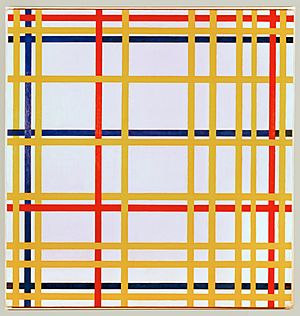
On September 23, 1940, Mondrian left Europe for New York. The new paintings he started in Manhattan were even more surprising. They showed a new style that was cut short by his death. New York City (1942) is a complex pattern of red, blue, and yellow lines. They sometimes cross over each other, creating a sense of depth. An unfinished version from 1941, New York City I, used strips of painted paper tape. Mondrian could move these strips to try out different designs. In 2022, it was found that New York City I had been displayed upside down for many years! The museum decided to keep it that way to avoid damaging it.
His painting Broadway Boogie-Woogie (1942–43) is very important in abstract geometric art. It has bright, shimmering squares of color. These colors seem to jump from the canvas, like neon lights. In this painting and the unfinished Victory Boogie Woogie (1942–1944), Mondrian replaced solid lines. He used lines made of small, connected rectangles of color. He sometimes used small pieces of colored tape. Larger colored rectangles also appear.
Mondrian's works from the 1920s and 1930s were very strict. But these New York paintings are bright and lively. They show the upbeat music that inspired them. They also show the energy of New York City. In these last works, the shapes became more important than the lines. This opened a new path for Mondrian's abstract art. The Boogie-Woogie paintings were a big change in his work.
In 2008, a Dutch TV show found the only known video of Mondrian. This discovery happened during research on Victory Boogie Woogie. The research showed the painting was in good shape. It also showed Mondrian painted it in one session. He made big changes to the painting just before he died, using small pieces of colored tape.
Studio Wall Works
When Piet Mondrian moved to Paris for the last time in 1919, he made his studio a perfect place for his art. He wanted it to express his ideas of Neoplasticism. To hide flaws in the studio walls, he put up large colored paper rectangles. He also added smaller colored paper squares and rectangles to the walls.
He would paint for a while, then rearrange the paper cutouts on his walls. This process helped him create new ideas for his next paintings. He followed this pattern for the rest of his life. He did this even when he moved to London in 1938 and 1940, and then to Manhattan.
In 1943, at age 71, Mondrian moved into his last studio in Manhattan. He made it a comfortable and inspiring place. He painted the walls off-white, like his easel and furniture. He even painted a stool and his radio-phonograph in bright red. Visitors to his studio often saw only one or two new paintings. But they were amazed by the eight large compositions of colored paper on his walls. These changing arrangements created a space that was both lively and peaceful. Mondrian said it was the best space he had ever lived in. He died only a few months later, in February 1944.
After he died, his friend Harry Holtzman and painter Fritz Glarner carefully recorded the studio with photos and film. They then opened it to the public for an exhibition. Before taking it apart, Holtzman traced the wall compositions. He made exact copies and attached the original paper pieces to them. These are now known as "The Wall Works." They have been shown in museums around the world.
Piet Mondrian's Death and Lasting Impact
Piet Mondrian passed away from pneumonia on February 1, 1944. He was buried at the Cypress Hills Cemetery in Brooklyn, New York.
On February 3, 1944, a memorial service was held for Mondrian. Nearly 200 people attended, including many famous artists. The Mondrian / Holtzman Trust now manages Mondrian's art. Its goal is to share his work and keep its artistic value safe.
Art critic Robert Hughes called Mondrian "one of the supreme artists of the 20th century." He also said Mondrian was one of the last painters who believed art could change human life. Dutch art historian Carel Blotkamp also agreed he was "one of the great artists of the twentieth century."
On November 14, 2022, Mondrian's Composition No. II sold for US $51 million at Sotheby's auction. This set a new record for his work. This painting is a 20-inch square canvas. It has a large red square, a small blue square, and a yellow block. All are outlined by black lines.
Artworks and Historical Ownership
Sometimes, the history of an artwork can be complicated. In October 2020, Mondrian's family started a legal process in a U.S. court. They sought the return of four paintings by Mondrian from a museum in Germany.
In December 2021, Mondrian's family also sought the return of his painting Composition with Blue (1928). This painting had been taken during a difficult historical period. It later came to be part of the Philadelphia Museum of Art's collection.
Remembering Mondrian
From June 6 to October 5, 2014, the Tate Liverpool museum showed the largest collection of Mondrian's works in the UK. This was to mark 70 years since his death. The exhibit, Mondrian and his Studios, included a life-size copy of his Paris studio. Charles Darwent wrote that Mondrian's studio was like a Mondrian painting itself. It had a black floor and white walls with movable red, yellow, and blue panels. Mondrian is known as "the world’s greatest abstract geometrist."
See also
 In Spanish: Piet Mondrian para niños
In Spanish: Piet Mondrian para niños
- Fourth dimension in art
- List of refugees
- Mondrian and Theosophy
- Piet (programming language)


